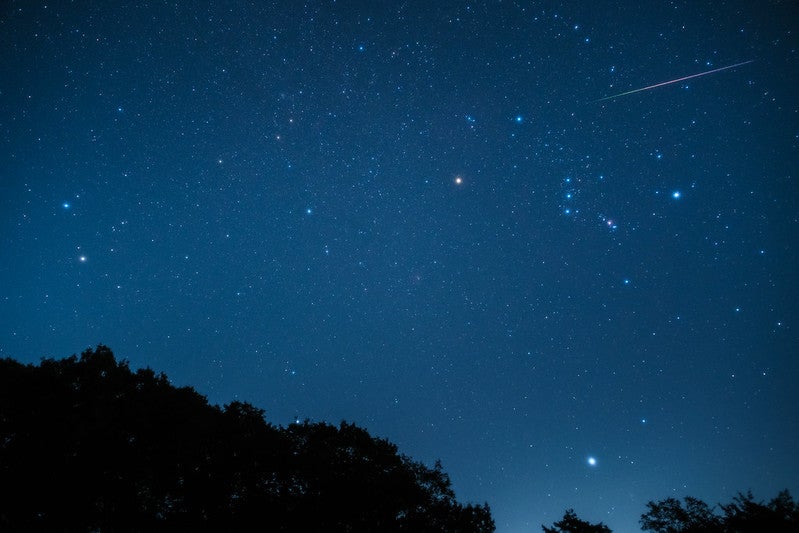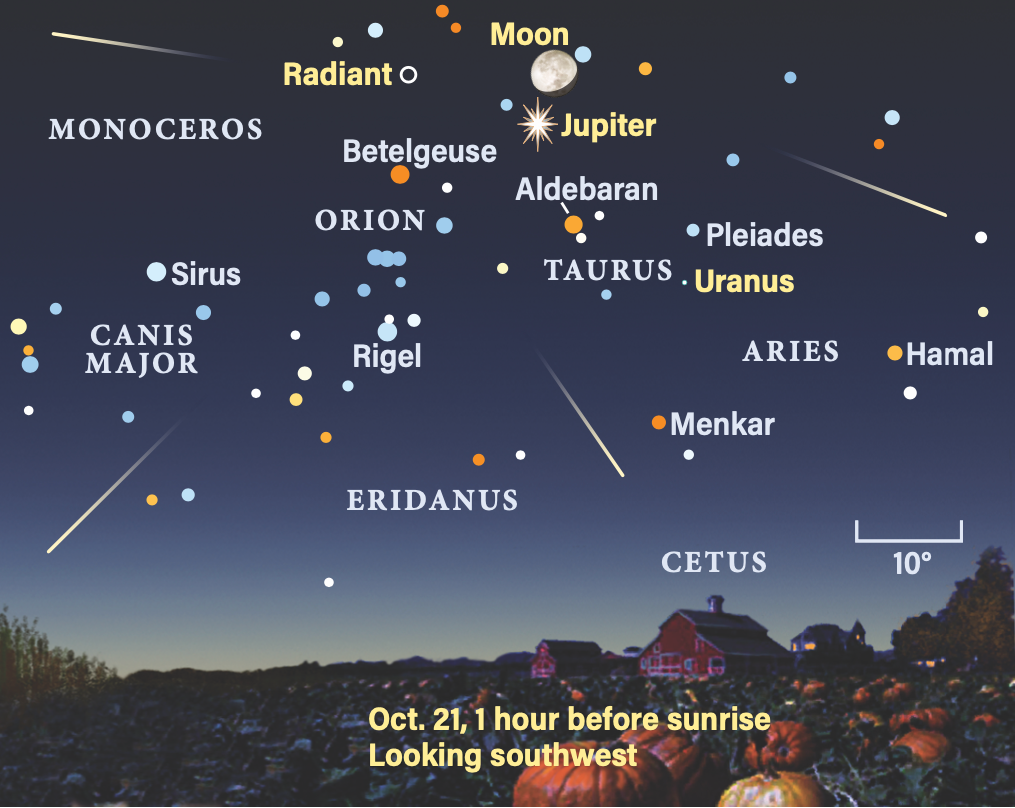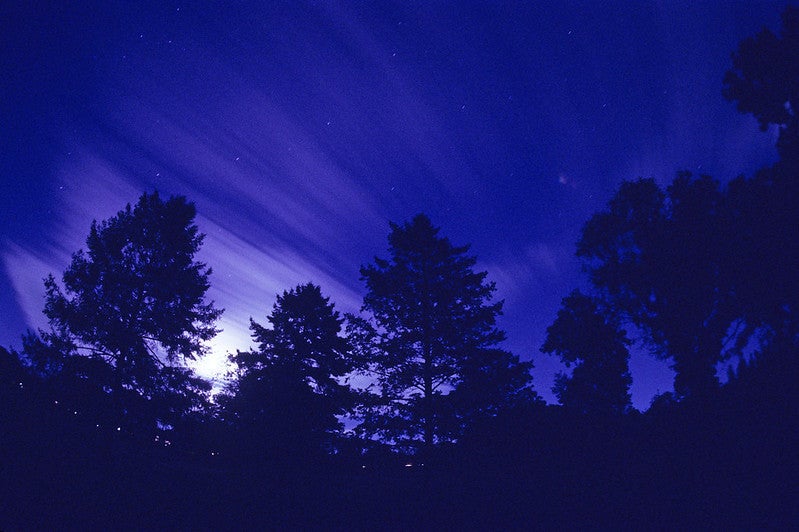
Friday, October 18
There’s still time to catch Comet C/2023 A3 (Tsuchinshan-ATLAS) in the west after sunset, even as it pulls away from the Sun and Earth on its way back toward the outer reaches of the solar system. Currently hovering between 1st and 2nd magnitude, the comet can be spotted with naked eyes from a dark site, but binoculars, a telescope, or even a smartphone camera will easily pick it up even with light pollution around.
The comet still sports a long, sweeping tail and stands some 30° high half an hour after sunset, offering plenty of time for viewing as twilight deepens. It’s now in Serpens and heading toward Ophiuchus, and tonight it hovers nearly 6° north-northwest of 3rd-magnitude Delta (δ) Ophiuchi. The region is setting as darkness falls, but you should get a good two hours of viewing before the comet gets too low, provided your horizon is clear. Note, though, that as it sinks lower the comet will get harder to see and look less impressive, so catching it as the last remnants of sunset are fading from the sky is best.
You can find more details on where and when to view Tsuchinshan-ATLAS for another few days in this article by Astronomy Associate Editor Michael E. Bakich.
And, while you’ve got your optics out, sweep your gaze some 11.5° southeast of the comet to view globular clusters M12 and M10 as well, both glowing just a bit brighter than 7th magnitude.
Sunrise: 7:14 A.M.
Sunset: 6:15 P.M.
Moonrise: 6:52 P.M.
Moonset: 8:43 A.M.
Moon Phase: Waning gibbous (98%)
*Times for sunrise, sunset, moonrise, and moonset are given in local time from 40° N 90° W. The Moon’s illumination is given at 12 P.M. local time from the same location.
Saturday, October 19
The Moon passes 4° north of Uranus at noon EDT. The pair rises in northwestern Taurus this evening around 7:30 P.M. local time; some two hours later, they have reached an altitude of 20°.
The waning gibbous Moon, still quite bright following its recent Full phase close to perigee (the closest point in its orbit to Earth), now lies to the left and slightly below Uranus, with some 9° separating them. Uranus, at magnitude 5.7, will require binoculars or a telescope to spot, particularly with the Moon nearby. The distant ice giant is 5.7° southwest of the the Pleiades (M45), one of the most famous star clusters in the sky. Uranus also lies quite close to a fainter, magnitude 7.6 field star this evening, just 7’ to the star’s northwest. If you find these two points of light in your optics, Uranus is the slightly brighter one, and may look more like a round, disklike, “flat” star.
The Moon currently occults the Pleiades monthly in a sequence that will last several more years, though most events occur during daylight in the U.S. However, next month the celestial lineup should be visible across the U.S., occurring overnight on Nov. 15/16.
Sunrise: 7:16 A.M.
Sunset: 6:14 P.M.
Moonrise: 7:32 P.M.
Moonset: 10:04 A.M.
Moon Phase: Waning gibbous (93%)
Sunday, October 20
Rising shortly before midnight and high in the sky in the early-morning hours, magnitude 0.2 Mars is brightening eastern Gemini, visible as a red point of light below the Twins’ two brightest stars, Pollux and Castor (Pollux sits southeast of Castor and is closer to the planet Mars). Early tomorrow morning, Mars will pass due south of Pollux, which sits to the planet’s upper left.
If you draw a line between these two points, pick the midpoint between them, and then draw another line to the lower left, you’ll find yourself smack in the middle of Cancer the Crab, which houses the bright, naked-eye star cluster M44. Far to the right (21°) of M44 as this region is still rising in the hours after midnight is magnitude 0.4 Procyon, the alpha star of Canis Minor the Little Dog. It’s the smaller, dimmer counterpart of Sirius, the Dog Star and nose of Canis Major the Big Dog — the brightest star in the sky. This magnitude –1.4 luminary sits another 25° to the right and slightly below Procyon; don’t worry, you can’t miss it! It lies directly below the three-star belt of Orion as they are rising in the eastern sky.
Sunrise: 7:17 A.M.
Sunset: 6:12 P.M.
Moonrise: 8:19 P.M.
Moonset: 11:22 A.M.
Moon Phase: Waning gibbous (85%)

Monday, October 21
The Orionid meteor shower peaks today, thought the bright Moon hovering near the radiant will certainly interfere. Nonetheless, if you’re up early — and there’s plenty to catch in the morning sky — keep an eye out for brighter Orionids, as at least some of the more spectacular shower members should still show up. With a rate of some 15 to 18 meteors per hour between 2 A.M. and dawn, you should catch a few, with most streaking away from the radiant in northeastern Orion, above the bright red star marking one shoulder, Betelgeuse.
As previously mentioned, there is other action in the early-morning sky as well. Mars, still in Gemini, passes 6° due south of Pollux at 2 A.M. EDT, still appearing to that star’s lower right, as it did yesterday.
Two hours later, the Moon passes 6° north of Jupiter at 4 A.M. EDT. The gas giant lies in eastern Taurus, near the two stars marking the points of the Bull’s horns, Alheka and Elnath. The Moon lies close to Elnath, cataloged as both Beta (β) Tauri and Gamma (γ) Aurigae, as it lies on the border of Taurus and Auriga. In fact, observers in Mexico, Central America, and southern Texas and Florida in the U.S. will see the Moon occult this star, passing in front of it and blocking it from view. Check the International Occultation Timing Association’s webpage for detailed timing from your location, if you’re in the lucky zone to catch this event.
Sunrise: 7:18 A.M.
Sunset: 6:11 P.M.
Moonrise: 9:17 P.M.
Moonset: 12:31 P.M.
Moon Phase: Waning gibbous (77%)
Tuesday, October 22
Standing nearly 30° high in the southeast an hour after sunset, Saturn is the brightest point of light in this region of the sky, outshining magnitude 1.2 Fomalhaut by half a magnitude. Observing the ringed planet through a telescope is one of the greatest joys of amateur astronomers the world over, and early tonight is an excellent time to take your turn.
The gas giant’s disk stretches a decent 19” across, wreathed by its stunning rings, which span more than twice the disk’s size, at 42”. The rings are tilted just slightly with respect to our point of view, showing off their northern edge. Can you also see the dark splash of Saturn’s shadow blocking out a small portion of the farside of the rings on the planet’s eastern side?
Early this evening, around 8:10 P.M. EDT, several of the ringed planet’s moons line up on either side of the world. Titan is brightest at 8th magnitude, standing some 2.5’ to Saturn’s west. To the east, 10th-magnitude Tethys, Dione, and Rhea are all alined, in that order from closest to farthest from the planet. Observers with large scopes may be able to make out a few even fainter moons, such as Mimas close to the planet to the west and Enceladus, between Tethys and Dione, to the east.
Starting just after 11 P.M. EDT, Tethys transits the southern portion of the disk, followed less than 90 minutes later by Enceladus. Tethys’ shadow falls exactly on the rings, and so will likely be unobservable, while Enceladus’ shadow skims the cloud tops just to the rings’ south. Experienced astrophotographers might be able to catch these transits using high-speed video capture and stacking techniques.
Sunrise: 7:19 A.M.
Sunset: 6:09 P.M.
Moonrise: 10:20 P.M.
Moonset: 1:30 P.M.
Moon Phase: Waning gibbous (67%)

Wednesday, October 23
The Moon, now tracking through Gemini, passes 4° north of Mars at 4 P.M. EDT. If you want to catch the pair early this morning, you’ll find Luna hanging above the Red Planet and to the right of Castor and Pollux a few hours before the Sun rises.
Already high in the east an hour after sunset is the Great Square of Pegasus, a famous asterism of four stars — one of which doesn’t technically fall within the bounds of the Winged Horse at all!
As it rises, the Great Square looks more like a diamond standing on its bottom point: This is magnitude 2.8 Algenib (Gamma Pegasi). Moving clockwise, we reach the “interloper,” magnitude 2.1 Alpheratz (Alpha [α] Andromedae). However, this star’s current status as part of Andromeda the Princess is a relatively recent development — it once did belong to Pegasus, as evidenced by the meaning of its name, which the late stellar expert Jim Kaler gives as “the horse’s shoulder” or “the horse’s navel.”
Continuing clockwise, the next star is magnitude 2.4 Scheat (Beta Peg), a red giant star that should look orange to your eyes through an eyepiece. And finally, magnitude 2.5 Markab (Alpha Peg) closes out the square.
Sunrise: 7:20 A.M.
Sunset: 6:08 P.M.
Moonrise: 11:28 P.M.
Moonset: 2:15 P.M.
Moon Phase: Waning gibbous (57%)
Thursday, October 24
Last Quarter Moon occurs at 4:03 A.M. EDT. This is the “morning Moon,” rising around midnight and visible throughout the morning hours, including during and after dawn. In fact, morning twilight can be the perfect pastel-colored backdrop for our natural satellite, as you can continue observing it even as the sunrise brightens the sky. Consider using binoculars or a small scope to enjoy this phase, though take extreme care never to point your optics anywhere near the Sun if observing around or after sunrise.
During this phase, the Moon’s western limb is illuminated and features appear lit in “reverse” for those used to seeing them in the evening during First Quarter. Along the terminator separating night and day, the eastern rim of Mare Imbrium is notable, as is the bright, rayed crater Copernicus to its south. To the west of Copernicus is a smaller, brighter pockmark — that’s Aristarchus, north of the smaller rayed crater Kepler.
Fully visible is Oceanus Procellarum, the Ocean of Storms. The largest of the Moon’s dark maria, or seas, this vast volcanic plain stretches more than 1,600 miles (2,500 kilometers) across. Its origins are unknown — a leading theory posits that it is an ancient impact basin following an asteroid strike on the Moon, but data from NASA’s GRAIL mission indicate it may have formed the same way as the Moon’s other seas, through internal volcanic processes.
Sunrise: 7:21 A.M.
Sunset: 6:00 P.M.
Moonrise: —
Moonset: 2:52 P.M.
Moon Phase: Waning crescent (46%)
Friday, October 25
Finally, the two bright points of light in the southwestern sky at sunset meet, as Venus passes 3° north of Antares at 3 P.M. EDT. Some 40 minutes after local sunset, you can catch Venus standing just to the upper right of Antares, the bright red star that marks Scorpius’ heart. The pair is some 8° high, so you’ll need a clear horizon.
Venus is the brighter point of light by far, glowing at magnitude –4. Antares, at 1st magnitude, is fainter but no slouch, its ruddy glow appearing as the twilight deepens.
By now, Comet Tsuchinshan-ATLAS has faded but stands high in the eastern sky in central Ophiuchus. At the same time (40 minutes after sunset), it is still 40° high, allowing for much more time to view it in a darker sky with no Moon. You’ll likely need binoculars or a camera to capture it by now, but either should do the job nicely, and there’s plenty of time to frame the perfect shot.
Sunrise: 7:22 A.M.
Sunset: 6:05 P.M.
Moonrise: 12:34 A.M.
Moonset: 3:21 P.M.
Moon Phase: Waning crescent (37%)

Sky This Week is brought to you in part by Celestron.

